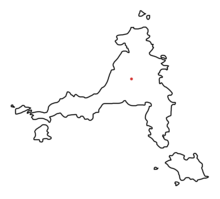| Insulanoplectron | |
|---|---|
| Scientific classification | |
| Domain: | Eukaryota |
| Kingdom: | Animalia |
| Phylum: | Arthropoda |
| Class: | Insecta |
| Order: | Orthoptera |
| Suborder: | Ensifera |
| Family: | Rhaphidophoridae |
| Subfamily: | Macropathinae |
| Tribe: | Macropathini |
| Genus: | Insulanoplectron Richards, 1970 |
| Species: | I. spinosum |
| Binomial name | |
| Insulanoplectron spinosum Richards, 1970 | |
Insulanoplectron is a genus of cave wētā in the family Rhaphidophoridae, with just one species: the Snares Island Wētā. Insulanoplectron spinosum is endemic to the subantartic Snares Island of New Zealand, where it is considered to be naturally uncommon. Wētā are nocturnal crickets found all around the world. During the day on the Snares, wētā can be found hiding in seabird burrows.
Taxonomy
Cave wētā were found on Snares Island in 1947 by R. A. Falla and C. A. Fleming. Detailed inferences could not be made about the species, as not many individuals had been found. In 1970, sufficient evidence had been collected, leading to I. spinosum being placed in a monophyletic group by Aola M. Richards. Richards noted that I. spinosum was distinct from other subantarctic Rhaphidophorids but shared traits with other species in New Zealand.
Distribution
Insulanoplectron spinosum is restricted to the Snares Island which lies 105 km to the south of Stewart Island.
Morphology
Although Insulanoplectron is distinct from other Rhaphidophoridae it has similarities in genital structure with Ischyroplectron hutton, another subantarctic weta. Insulanoplectron spinosum are dark brown in colour with light brown bands around the body, and an ovipositor that is reddish brown colour. Female Insulanoplectron spinosum adults are larger than males. Body length of adult males is around 14mm while female body length varies between 17 - 18mm. Between the beginning (egg) and final life stages (adult) there are several instar stages that individuals need to moult to allow for features to transition from being juvenile to those of an adult. Male I. spinosum have eight instar stages, while females have nine of these pre-adult instar stages.
Diet
Analysis of I. spinosum diet found that individuals consumed a variety of plants, invertebrates and one vertebrate species. Plants found in the crop of male and female individuals of varying ages was determined to be a combination of algae, vascular plants, and fungi. While invertebrates detected in captured wētā include: Isopoda, Collembola, Tenebrionidae, Lepidoptera, Muscidae. In both male and female wētā Aves had been detected in all individuals regardless of age, this was determined to be seabird carcass. Individuals of I. spinosum have been observed to cannibalise other individuals who are smaller, lethargic, or are missing appendages.

References
- "Critters of the Snares Islands". Te Papa’s Blog. 2014-03-07. Retrieved 2023-08-30.
- Trewick, S., Hegg, D., Morgan-Richards, M., Murray, T., Watts, C., Johns, P., & Michel, P. (2022). Conservation status of Orthoptera (wētā, crickets and grasshoppers) in Aotearoa New Zealand, 2022. In Department of Conservation. https://www.doc.govt.nz/globalassets/documents/science-and-technical/nztcs39entire.pdf
- ^ "Cave wētā". www.visitzealandia.com. Retrieved 2023-08-30.
- ^ Butts, C. A. (1984). The biologies of two species of weta endemic to the snares island Zealandrosandrus subantarcticus Salmon (Orthoptera: Stenopelmatidae) and Insulanoplectron spinosum Richards (Orthoptera: Rhaphidophoridae) . https://ir.canterbury.ac.nz/server/api/core/bitstreams/5b27b533-c676-438b-bd89-36d73da30cc5/content
- Richards, Anola M. (25 December 1970). "Revision of the Rhaphidophoridae (Orthoptera) of New Zealand Part XIII. A new genus from the Snares Islands" (PDF). Pacific Insects. 12 (4): 865–869 – via Hawaii Biological Society - Bishop Museum.
- ^ Richards, A. M. (1972). Revision of the Rhaphidophoridae (Orthoptera) of New Zealand. Part XIV. Three alpine genera from the South Island. Journal of the Royal Society of New Zealand, 2(2), 151–174. doi:10.1080/03036758.1972.10429371
- "Expedition to Snares Island". Museum of New Zealand Te Papa Tongarewa, Wellington, NZ. 2017-08-22. Retrieved 2023-09-01.
- Richards, Aola M. (December 1974). "Arthropoda of the subantarctic islands of New Zealand". New Zealand Journal of Zoology. 1 (4): 495–499. doi:10.1080/03014223.1974.9517849. ISSN 0301-4223.
- Gibbs, G. (2007, September 24). Wētā - Tree wētā. Teara.govt.nz; Te Ara - the Encyclopedia of New Zealand. https://teara.govt.nz/en/weta/page-2
- Hegg, Danilo; Morgan-Richards, Mary; Trewick, Steven A. (2022-04-04). "High alpine sorcerers: revision of the cave wētā genus Pharmacus Pictet & de Saussure (Orthoptera: Rhaphidophoridae: Macropathinae), with the description of six new species and three new subspecies" (PDF). European Journal of Taxonomy (808). doi:10.5852/ejt.2022.808.1721. ISSN 2118-9773.
| Taxon identifiers | |
|---|---|
| Insulanoplectron |
|